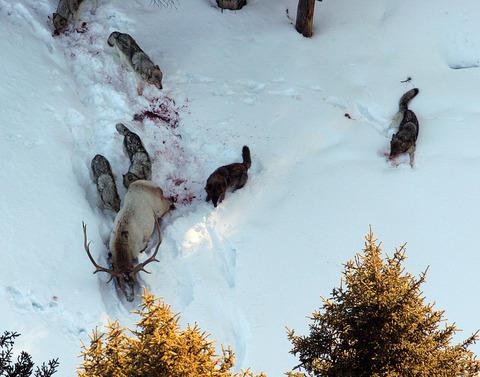当前位置:
X-MOL 学术
›
J. Anim. Ecol.
›
论文详情
Our official English website, www.x-mol.net, welcomes your feedback! (Note: you will need to create a separate account there.)
How climate impacts the composition of wolf killed‐elk in northern Yellowstone National Park
Journal of Animal Ecology ( IF 4.8 ) Pub Date : 2020-03-27 , DOI: 10.1111/1365-2656.13200 Christopher C Wilmers 1 , Matthew C Metz 2, 3 , Daniel R Stahler 2 , Michel T Kohl 4 , Chris Geremia 2 , Douglas W Smith 2
Journal of Animal Ecology ( IF 4.8 ) Pub Date : 2020-03-27 , DOI: 10.1111/1365-2656.13200 Christopher C Wilmers 1 , Matthew C Metz 2, 3 , Daniel R Stahler 2 , Michel T Kohl 4 , Chris Geremia 2 , Douglas W Smith 2
Affiliation

|
Abstract While the functional response of predators is commonly measured, recent work has revealed that the age and sex composition of prey killed is often a better predictor of prey population dynamics because the reproductive value of adult females is usually higher than that of males or juveniles. Climate is often an important mediating factor in determining the composition of predator kills, but we currently lack a mechanistic understanding of how the multiple facets of climate interact with prey abundance and demography to influence the composition of predator kills. Over 20 winters, we monitored 17 wolf packs in Yellowstone National Park and recorded the sex, age and nutritional condition of kills of their dominant prey—elk—in both early and late winter periods when elk are in relatively good and relatively poor condition, respectively. Nutritional condition (as indicated by per cent marrow fat) of wolf‐killed elk varied markedly with summer plant productivity, snow water equivalent (SWE) and winter period. Moreover, marrow was poorer for wolf‐killed bulls and especially for calves than it was for cows. Wolf prey composition was influenced by a complex set of climatic and endogenous variables. In early winter, poor plant growth in either year t or t − 1, or relatively low elk abundance, increased the odds of wolves killing bulls relative to cows. Calves were most likely to get killed when elk abundance was high and when the forage productivity they experienced in utero was poor. In late winter, low SWE and a relatively large elk population increased the odds of wolves killing calves relative to cows, whereas low SWE and poor vegetation productivity 1 year prior together increased the likelihood of wolves killing a bull instead of a cow. Since climate has a strong influence on whether wolves prey on cows (who, depending on their age, are the key reproductive components of the population) or lower reproductive value of calves and bulls, our results suggest that climate can drive wolf predation to be more or less additive from year to year.
中文翻译:

气候如何影响黄石国家公园北部狼杀麋鹿的组成
摘要 虽然通常测量捕食者的功能反应,但最近的工作表明,被杀死的猎物的年龄和性别组成通常是猎物种群动态的更好预测指标,因为成年雌性的繁殖价值通常高于雄性或幼鱼。气候通常是决定捕食者死亡构成的重要中介因素,但我们目前缺乏对气候的多个方面如何与猎物丰度和人口统计学相互作用以影响捕食者死亡构成的机制理解。在 20 多个冬天,我们在黄石国家公园监测了 17 只狼群,记录了它们的优势猎物——麋鹿——在早冬和晚冬时期分别处于相对良好和相对较差的状态时的性别、年龄和营养状况. 被狼杀死的麋鹿的营养状况(如骨髓脂肪百分比所示)随着夏季植物生产力、雪水当量 (SWE) 和冬季时期的变化而显着变化。此外,被狼杀死的公牛,尤其是小牛的骨髓比母牛的骨髓更差。狼猎物的组成受到一组复杂的气候和内生变量的影响。在初冬,t 年或 t-1 年植物生长不佳,或麋鹿丰度相对较低,增加了狼杀死公牛的几率。当麋鹿丰度高并且它们在子宫内经历的草料生产力很差时,小牛最有可能被杀死。在冬末,低 SWE 和相对较大的麋鹿种群增加了狼杀死小牛相对于奶牛的几率,而一年前的低 SWE 和较差的植被生产力共同增加了狼杀死公牛而不是母牛的可能性。由于气候对狼捕食奶牛(根据它们的年龄,它们是种群的关键繁殖组成部分)还是降低小牛和公牛的繁殖价值有很大影响,我们的结果表明,气候可以驱使狼捕食更多或逐年减少添加剂。
更新日期:2020-03-27
中文翻译:

气候如何影响黄石国家公园北部狼杀麋鹿的组成
摘要 虽然通常测量捕食者的功能反应,但最近的工作表明,被杀死的猎物的年龄和性别组成通常是猎物种群动态的更好预测指标,因为成年雌性的繁殖价值通常高于雄性或幼鱼。气候通常是决定捕食者死亡构成的重要中介因素,但我们目前缺乏对气候的多个方面如何与猎物丰度和人口统计学相互作用以影响捕食者死亡构成的机制理解。在 20 多个冬天,我们在黄石国家公园监测了 17 只狼群,记录了它们的优势猎物——麋鹿——在早冬和晚冬时期分别处于相对良好和相对较差的状态时的性别、年龄和营养状况. 被狼杀死的麋鹿的营养状况(如骨髓脂肪百分比所示)随着夏季植物生产力、雪水当量 (SWE) 和冬季时期的变化而显着变化。此外,被狼杀死的公牛,尤其是小牛的骨髓比母牛的骨髓更差。狼猎物的组成受到一组复杂的气候和内生变量的影响。在初冬,t 年或 t-1 年植物生长不佳,或麋鹿丰度相对较低,增加了狼杀死公牛的几率。当麋鹿丰度高并且它们在子宫内经历的草料生产力很差时,小牛最有可能被杀死。在冬末,低 SWE 和相对较大的麋鹿种群增加了狼杀死小牛相对于奶牛的几率,而一年前的低 SWE 和较差的植被生产力共同增加了狼杀死公牛而不是母牛的可能性。由于气候对狼捕食奶牛(根据它们的年龄,它们是种群的关键繁殖组成部分)还是降低小牛和公牛的繁殖价值有很大影响,我们的结果表明,气候可以驱使狼捕食更多或逐年减少添加剂。


























 京公网安备 11010802027423号
京公网安备 11010802027423号